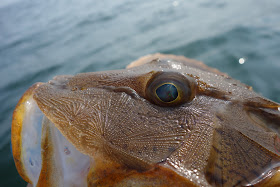A couple weekends ago I wanted to show my friend Brandon some good bonito fishing either in CT or Rhode Island. We ended up going about as far east as I was willing, because that's where the party was. Under cloudy skies and with a east-northeast wind blowing, we launched and set out into waters where, unbeknownst to either of us, a great white had been seen just days before. Actually, Ian Devlin and I had been there while that tagged shark was there. I would have loved to have seen it then, but I'm pleased it didn't show up with Brandon and I out there in our kayaks.
Initially, we waited around in close for fish to show. There wasn't much sign of life though, and there was a cluster of boats about a mile out, so we meandered over to check it out. Again we saw no breaks and not much bait, so we both turned to fishing deep. That bite was going strong, with porgies and smaller black sea bass being the major players. I kept hoping a grey triggerfish or some kind of snapper would come up.
 |
| Stenotomus chrysops |
Towards the end of one drift I felt a very subtle take and set into what felt like another tiny sea bass. I began reeling up the fish when suddenly, ten cranks in, it woke up and revealed that it wasn't tiny at all. My five weight doubled over as the fish ran back down towards the bottom, taking 30 feet of line. It dogged be for a little while, making me wonder just what I'd hooked into. Then I got it topside, and it was the biggest black sea bass I'd ever seen in person. An elephant had, once again, found my peanut.
 |
| Centropristis striata (photo courtesy Brandon Hakulin) |
 |
| (photo courtesy Brandon Hakulin) |
I hooked up in after a bit of chasing the school around. They had thinned out a bit and weren't breaking, but I could see flashes deeper in the water column. In all likelihood these fish were working cleanup, taking stunned or dead silversides, missed casualties of the initial blitz. Eventually one of those flashes was on my fly.
 |
| Sarda sarda |
We chased the bonito up and down the channel for a bit before Brandon decided he was better off on the rocks. He landed and walked out the Jetty, I stayed in my kayak. I was in perfect position to photograph and fish the next school that erupted in the eddy.
As that blitz dissipated I hooked up again. It was the same scenario as the first, after the bait spread out and the surface breaks ceased cleanup crew took the leftovers.
That action continued for a solid hour after that. I missed three more takes on the fall (a big albie taking a fly on the fall almost always hooks itself, but these little bonito... not so much) and didn't catch another, but I'd doubled my total lifetime bonito count so I was happy. Unfortunately for Brandon, beginners luck didn't kick in. He had one swipe and no hookups. I think it's likely that my full sinking line helped substantially, as well as my relatively slow retrieve. I only saw to other hookups and there were easily 50 people casting to those fish.
Then, Brandon fell in. Thank God he didn't capsize, but falling in at all in the middle of a channel is not a good situation. Luckily no trawlers or ferries were coming through and we were off to the side of the channel, but that did pretty much put an end to our kayaking there. The bonito had left anyway, and it was going to start to rain.
The day was still young though, and we soon found ourselves on the boat with Phil Sheffield, watching some of the best schoolie striper blitzes of August in a heavy rain squall. But that was legitimately too much to talk about any more than that...
Until next time.
Fish for the love of fish.
Fish for the love of places fish live.
Fish for you.
If you enjoy what I'm doing here, please share and comment. It is increasingly difficult to maintain this blog under dwindling readership. What best keeps me going so is knowing that I am engaging people and getting them interested in different aspects of fly fishing, the natural world, and art. Follow, like on Facebook, share wherever, comment wherever. Also, consider supporting me on Patreon (link at the top of the bar to the right of your screen, on web version). Every little bit is appreciated! Thank you to my Patrons; Erin, David, john, Elizabeth, and Christopher, for supporting this blog.









































































